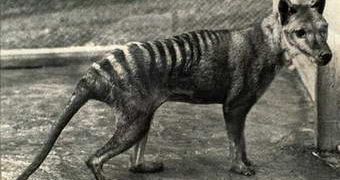The last Tasmanian tiger, thylacine, died in captivity in 1936 at Hobart Zoo after being hunted to extinction during the early 1900s. Fortunately, some thylacine pouch young and adult tissues were preserved in alcohol by museums around the world. One of those is Museum Victoria in Melbourne which donated some samples to the University of Melbourne and the University of Texas, to be used in a study investigating the functionality of the thylacine genome.
Researchers extracted genes from the Tasmanian tiger DNA and then inserted them into a mouse. The results reveal that the Col2a1 gene of thylacine has the same functionality as the Col2a1 gene in a mouse, more exactly that of controlling the development of bone and cartilage.
"This is the first time that DNA from an extinct species has been used to induce a functional response in another living organism. As more and more species of animals become extinct, we are continuing to lose critical knowledge of gene function and their potential. Up until now we have only been able to examine gene sequences from extinct animals. This research was developed to go one step further to examine extinct gene function in a whole organism", said Dr Andrew Pask, from the University of Melbourne's Department of Zoology.
"This research has enormous potential for many applications including the development of new biomedicines and gaining a better understanding of the biology of extinct animals", said Professor Richard Behringer, Deputy Head of the Department of Molecular Genetics, M.D. Anderson Cancer Center, at the University of Texas.
After isolating the DNA strand from the century old sample, it was authenticated as belonging to a thylacine, then inserted into a mouse embryo. The thylacine DNA strand was then activated and triggered the development of mouse cartilage, which would later become bone.
"At a time when extinction rates are increasing at an alarming rate, especially of mammals, this research discovery is critical. For those species that have already become extinct, our method shows that access to their genetic biodiversity may not be completely lost", says Professor Marilyn Renfree, Federation Fellow and Laureate Professor in the University of Melbourne's Department of Zoology.

 14 DAY TRIAL //
14 DAY TRIAL //